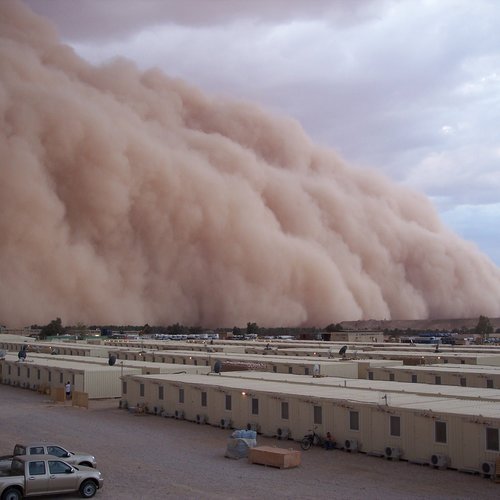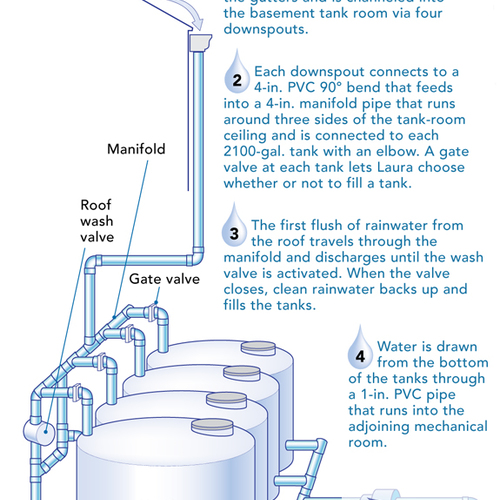
Gathering water has always been a big deal, but in recent times, technology has made water accessible to most everyone in the United States, even those inhabitants of historically arid regions. (Witness the acres of golf courses and green lawns in the deserts of Las Vegas or Phoenix.) However, because of pollution, overuse, and changes in weather patterns, a consistent supply of clean water everywhere is no longer a sure thing. And while it hasn’t become a full-blown ecological crisis in most parts of the country, water is now a topic that’s increasingly hard to ignore.
A viable resource
The process of rainwater harvesting isn’t complicated: Collect rainwater from a roof and divert it from the gutters into a storage tank. Systems can range from a 55-gal. rain barrel to underground tanks that hold in excess of 50,000 gal. Homeowners themselves can install many of the systems, but most suppliers offer installation services as well. The important factors that determine the type and size of a system are the amount that can be collected and the water’s end use.
Over the last few decades, homeowners and businesses alike have been turning to rainwater harvesting. It’s proven to be a viable alternative to using well water during dry spells, allowing homeowners to water lawns, wash dishes, bathe, and drink freely. For others, rainwater harvesting provides an alternative to using mineral-laden well water, or a way to control stormwater runoff. For builders and architects using the LEED program, certain applications can qualify for points.
Of course, collecting rain has been part of standard building practices for centuries in historically dry regions of the world, and it’s now on a global comeback. Rainwater harvesting is integrated into the municipal infrastructure in Singapore and is required for all new…
Weekly Newsletter
Get building science and energy efficiency advice, plus special offers, in your inbox.

This article is only available to GBA Prime Members
Sign up for a free trial and get instant access to this article as well as GBA’s complete library of premium articles and construction details.
Start Free TrialAlready a member? Log in















20 Comments
We read a great book on the topic, a guide for home scale systems by an engineer/permaculturalist. https://newsociety.ca/books/e/essential-rainwater-harvesting?sitedomain=ca
While building our house, rainwater harvesting has quickly fallen to the very bottom of the priority list because of the cost. Perhaps some day we will purchase a big steel tank, but in the meantime we decided to just connect the downspouts to underground PVC pipes which we will run to garden areas and connect to buried big O, weeping tile, for passively irrigated perennials. This is very cheap to do. Watering the roots directly is also good because you eliminate the surface evaporation when you spray the water from above or even a drip line.
For anyone with a bit of land and elevation change, we recently learned about ram pumps. We will build one to pump water from a pond at the bottom of our hill up to the top where house and gardens are - all without electricity and for a pretty low cost.
PVC in the USA contains phthalates and other chemicals. Take a look at alternatives for your use case.
graygreen,
Are you sure?
"Phthalates are typically used in flexible PVC tubing to make it pliable. Phthalates are not present in rigid PVC pipe and fittings formulations. "
What alternatives would you suggest?
Thanks for the correction, rigid pipe does not have phthalates (actually it could, but the amount would be very small) according to this Wikipedia article: https://en.wikipedia.org/wiki/Polyvinyl_chloride
However, rigid pipe still gets other additives. Lead is a common additive. Here you can buy some lead stabilizer explicitly for making rigid pipe: https://www.novistachem.com/one-pack-lead-stabilizer/56953289.html
In the Wikipedia article it says "In Europe the use of lead-based stabilizers has been discontinued." They also removed cadmium. Not so in the US. Most water hoses, at least in the US, also have lead! I buy my hoses from Water Right of Oregon.
The best alternatives are usually considered to be copper or stainless steel. Depending on the application, PEX might be possible (I used it to plumb my rain barrels where it is above ground, with no direct UV, no freezing water, and only small diameter is needed. It's not a lot of pipe- if it wears out I can replace it and my cost is really just my labor.
It's possible you could find some "European" PVC that might have very limited toxicity. I generally don't trust any claims around toxicity that a company makes though without third party verification. Inherently non-toxic materials is what I look for.
greygreen,
Sorry I'm still a bit unclear what you are suggesting. Are you saying rigid PVC pipes, such as those y0u would use to plumb a rain-water collection system contains the plasticizers and stabilizers you are worried about?
Malcom, you should assume rigid PVC pipe has heavy metals- lead and cadmium- unless you have managed to verify otherwise. It might have zero plasticizers but if it had any it would be a tiny amount.
You can do research to try to figure out how much these leach. Personally I try to avoid anything with any known amount of heavy metal contamination if it is related to food or water or would otherwise end up inside the body.
As the first illustration in the article shows, tank are often located next to the house and fed from above. Neither of those are necessary. As long as the top of the tank is lower than the gutters, and the pipes between them are solid, the tank an be anywhere. The lines can run underground between the two, with the tank being fed from the bottom. You do need to incorporate a cleanout to periodically remove sediment at the lowest level.
I think the underground conveyance systems are very cool! Seems much smarter to bring the water to an area a bit away from the house such as near a garden where you might want the water. The idea of so much water sitting right against the foundation scares me 😂
Izzza,
Here in our seismically active area, we now have to get water tanks engineered if they are near a house.
Sounds expensive! Engineered how? We really like the look of these German rain tanks:
https://www.graf.info/en/rainwater-harvesting/tanks-underground/rainwater-tank-herkules/herkules-tank-set.html
Izzza,
Seismic hold-downs.
Most people here use plastic tanks and keep them away from the house. They are running about $1.50 a imp gal now.
Has anybody out there designed or is using a system that catches water and moves it to a tank located inside the house? I am designing such a system and would love to connect with someone who has some experience. Underground tank storage is not an option and it needs to be protected from freezing.
spephen2,
I've had experience with two.
My neighbour has a double garage with a crawlspace about four feet deep that is lined with a membrane. It collects the roof top water for all their domestic use.
Another neighbour has a 1000 imp gal plastic tank in their walk-out basement that mixes domestic grey water with run off from their roof.
Both systems fairly closely mimic the first illustration, except for the tank shape and location. Both seem to work well.
Thanks Malcolm, mine will be 500 gallons, plastic, and be in the utility room. Two questions. Will it need to be vented through the roof or just into the utility room? Also, there are two overflow pipes in the above diagram. Is it possible to run these pipes to my grey water pump (also in the utility room) or should i create another penetration for them through the outside wall? I have a lot of roof area and it rains a bunch here in Maine. Shouldn't be a problem collecting 500 gallons. It seems to be a choice between another penetration and hearing the pump run during rain storms,
stephenr,
No need for any vent other than a big enough hole in the lid to equalize pressure as the tank fills and empties.
The one overflow is on the debris filter and should stay outside. You shouldn't get much volume from that. The overflow from the tank should drain to somewhere that doesn't require a pump. With a 500 gal tank you can end up with long periods where the roof is draining straight though the full tank at quite a high volume. My neighbour with the crawlspace cistern collects over 60K imp gal a year. It doesn't make much sense to have to pump that, and it also introduces the risk of floods if the pump malfunctions. Don't forget a floor drain in the utility room.
For smaller water needs, I like the blue barrel system. It is designed to be able to reuse industrial food processing barrels and to use an under-plumbing system. Barrels can be chained together to create larger installations. I used pex and sharkbite connectors rather than PVC though. https://www.bluebarrelsystems.com/
Is a metal roof mandatory for water collection? Or can comp shingle roofs be used as well? If so, what are some considerations for the planning stages? If one needs to have a metal roof it would seem to me that the cost of the whole system - on an existing comp shingle home - might well be a significant consideration.
Thanks in advance for any insights!
composite cost seems similar to metal. In the linked EPA document composite is not mentioned: https://www.epa.gov/sites/default/files/2015-11/documents/rainharvesting.pdf
It seems like composite could be made of lots of different things. Including recycled materials. Recycling is nice, but its a source of contaminants that is difficult to control. The EPA recommends sampling water quality prior to use for asphalt shingles and galvanized metal. For composite you would want to first try to figure out what your composite is actually made of to see if you would rule it out. If you want to try to use it I assume you would need to sample the water quality first.
For any roof my assumption is it would be best to let it get a lot of rain first (ideally go through a year of seasonal weather changes) to get rid of any initial contaminants- no data to back that up though.
Composition shingle roofing is another term for asphalt shingles, which are fiberglass-reinforced in their modern form. The EPA document says to watch out for lead and mercury, and to test the water before use.
dfchase,
Not mandatory, but definitely recommended if you want to use the water for domestic use, not just irrigation.
Log in or become a member to post a comment.
Sign up Log in